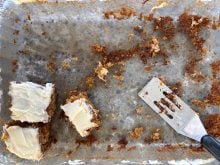Class simplifies surfing the internet for information, recipes
During this past month, I participated in a couple of internet and e-mail classes at our local regional college. I have used both but felt I needed something to make me more confident in my surfing.
When I arrived at my first class I was surprised to discover that I was probably the youngest person in the class. The majority of my classmates were retirees and there were three husband and wife couples. In our chats at coffee time, participants said their main reason for taking the class was to communicate with their children and grandchildren. One couple said that they were feeling out of the communication link and wanted to be included in the conversations.
Read Also

VIDEO: Bittersweet harvest for this family farmhand
Bruce Burnett helps his brother harvest wheat and canola for the last time on the family farm in Manitoba where they both grew up.
Others in the class wanted to communicate with friends and look up information on the internet.
Learning how to do successful searches is one of my goals. Our instructor, Tara Lee Whittaker, explained there are different search engines or special websites that take words typed by users and look for websites and pages matching the description or words. A spider search engine uses a computer program that “crawls” across the web and attempts to index virtually every website and its contents that it crosses. The database of a spider search engine is huge and when you search by keyword, it will look for that word in both the titles of the page and within the content of the page.
An easier way of searching, in Tara’s view, is to do a search using a web directory. Web directories categorize websites by subject. When you perform a search, it will look for your keyword only within the title and the short description provided by the site’s webmaster. Directories also tend to be selective and thus the volume of sites will be smaller than that of a spider search engine.
To find the answer to a specific question try Ask Jeeves at www.aj.com.
For information on buying household items try www.how2.com.
If you don’t have your own computer, most public libraries in smaller communities are developing public access programs.
I discovered if you enter two or three words (no capitals and no spaces) but join the words with the “+” sign you will get a more specific search. I tried this to find a burnt sugar cookie recipe that one of our readers had requested.
We hadn’t been successful in finding it in a cookbook but in a few minutes I had found one burnt sugar cookie recipe using the search engine at www.yahoo.com using burnt+sugar+cookie for the search. I have tried it and made a few additions to the method portion of the recipe.
Burnt sugar cookies
2 cups sugar 500 mL
1 cup boiling water 250 mL
3 eggs
1 cup lard 250 mL
1 tablespoon ginger 15 mL
1 cup sour milk 250 mL
pinch of salt
3 tablespoons baking 45 mL
soda
2 cups sugar 500 mL
7 cups flour 1.75 L
Put the sugar in skillet, stir until it is melted and looks like molasses. Remove from heat when sugar has become dark brown. Slowly pour the boiling water into the melted sugar. Mix the eggs, lard, ginger, sour milk and salt while melted sugar and water cool.
Add soda to melted sugar and stir well. Pour egg and milk mixture into sugar syrup mixture, then work in other sugar and flour to make stiff dough. Drop on baking sheet by teaspoonful. Bake in 375 F (190 C) oven for 10-12 minutes. Source: Dortha Reed, Benrock Grange, Noble County, Ohio from the website www.ichef.com. The same reader also asked for a peanut brittle recipe.
Peanut brittle
2 cups baking 500 mL
peanuts (skins removed)
2 cups granulated 500 mL
sugar
1Ú2 cup light brown 125 mL
sugar
1Ú4 teaspoon baking soda 1 mL
1Ú4 teaspoon salt 1 mL
In a heavy frying pan slowly melt and lightly caramelize the sugars. Add the salt, soda and peanuts and pour into a well-buttered shallow pan. When cold, break into pieces.
Greek dessert
Another search I did on the internet was to answer a request by H.A.G., of Hodgeville, Sask., for a Greek dessert recipe.
Using greek+dessert+recipe at the www.netscape.com search site I was able to find a Greek desserts/baking link. From there, I found a phyllo and custard pastry called Galaktoboureko. This must be kept in the fridge because it contains milk.
I searched my files and internet but haven’t found a recipe for making phyllo pastry. Would any of our readers have ever made it?
Galaktoboureko
6 cups milk 1.5 L
1 cup fine semolina 250 mL
(cream of wheat)
31Ú2 tablespoons 55 mL
cornstarch
3 cups granulated 750 mL
sugar
1Ú4 teaspoon salt 1 mL
6 eggs
1 teaspoon vanilla 5 mL
extract, optional
1 tablespoon butter 15 mL
16 frozen phyllo sheets,
thaw in fridge overnight
3Ú4 cup butter, 175 mL
melted and hot
1 cup water 250 mL
1 lemon or orange,
peel only
2 tablespoons fine 30 mL
brandy or cognac, optional
In a heavy-bottomed, three-quart saucepan, bring the milk gradually to a boil. Do not allow it to scorch.
Meanwhile, sift the semolina, cornstarch, one cup (250 mL) of the sugar, and salt together and gradually add to the boiling milk, stirring constantly with a wooden spoon. Cook slowly over medium heat until the mixture thickens and comes to a full boil, then remove from the heat.
Beat the eggs on high speed of an electric mixer.
Gradually add 1Ú2 cup (125 mL) sugar and continue beating until thick and fluffy, about 10 minutes, then add the vanilla. Stirring constantly, add eggs to the hot pudding.
Partially cover the pan and allow to cool. Butter a 9 x 12 x 3 inch (22 x 30 x 7 cm) baking pan and cover the bottom with 10 sheets of the phyllo, brushing butter generously between each and making sure that a few sheets come up the pan sides.
Pour the custard into the pan over the phyllo. Cover with the six remaining sheets, brushing butter between each and on the surface.
With the tip of a sharp knife, score the top sheets into square or diamond shapes, being careful not to score as deeply as the custard.
Bake on the centre rack of a moderate 350 F (180 C) oven for 40 to 45 minutes, until crisp and golden chestnut in color and the custard is firm.
Boil the remaining 11Ú2 cups (375 mL) sugar with the water and lemon or orange peel for five minutes. Add the brandy or cognac, if desired, and set aside. Remove the galaktoboureko from the oven and set on a cake rack. Spoon the hot syrup over the entire galaktoboureko, particularly the edges. Cool thoroughly before cutting and serving. Store in the refrigerator.
From: The Food of Greece by Vilma Liacouras Chantiles, Avenel Books, New York. Source: Karen Mintzias I-Cooking.
















